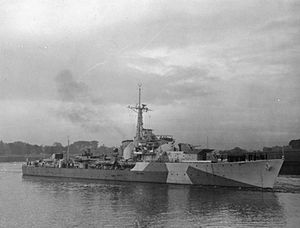 Caesar upon completion, October 1944
| |
| History | |
|---|---|
| Name | Caesar |
| Ordered | 16 February 1942 |
| Builder | John Brown, Clydebank |
| Laid down | 3 April 1943 as Ranger |
| Launched | 12 February 1944 |
| Completed | 3 October 1944 |
| Commissioned | 17 July 1944 |
| Renamed | Renamed Caesar before launch |
| Identification | Pennant number: R07 initially, but changed to D07 in 1945 |
| Motto | Veni, vidi vici |
| Honours and awards | Glorious First of June 1794 - Cut of Gibraltar 1801 - Strachan's Action 1805 - Basque Roads 1809 - Walcheren 1809 - Baltic 1854 |
| Fate | Sold for scrap, 13 December 1966 |
| Badge | On a Field Blue, the head of Caesar, gold |
| General characteristics (as built) | |
| Class and type | C-class destroyer |
| Displacement | 1,730 long tons (1,760 t) (standard) |
| Length | 362 ft 9 in (110.6 m) o/a |
| Beam | 35 ft 8 in (10.9 m) |
| Draught | 14 ft 6 in (4.4 m) (full load) |
| Installed power |
|
| Propulsion | 2 shafts; 2 geared steam turbines |
| Speed | 36 knots (67 km/h; 41 mph) |
| Range | 4,675 nautical miles (8,658 km; 5,380 mi) at 20 knots (37 km/h; 23 mph) |
| Complement | 222 |
| Armament |
|
HMS Caesar was one of thirty-two C-class destroyers built for the Royal Navy during the Second World War, a member of the eight-ship Ca sub-class. Commissioned in 1944, she was built as a flotilla leader with additional accommodation for staff officers. The ship was assigned to Home Fleet during 1944–1945 and escorted one Arctic convoy as well as the capital ships of the fleet.